



Giorgio de Chirico was born to Italian parents in Volos Greece, on July 10, 1888. In 1900 he began studies at the Athens Polytechnic Institute and attended evening classes in drawing from the nude. De Chirico moved to Milan in 1909, to Florence in 1910, and to Paris in 1911. In Paris he was included in the Salon d'Automne in 1912 and 1913 and in the Salon des Indépendants in 1913 and 1914. Because of the war, in 1915 de Chirico returned to Italy, where he met Filippo de Pisis in 1916 and Carlo Carrà in 1917; they formed the group that was later called the Scuola Metafisica.

The artist moved to Rome in 1918, and was given his first solo exhibition at the Casa d'Arte Bragaglia in that city in the winter of 1918–19. In this period he was one of the leaders of the Gruppo Valori Plastici, with whom he showed at the Nationalgalerie in Berlin. A solo exhibition of de Chirico's work was held at the Galleria Arte in Milan in 1921, and he participated in the Venice Biennale for the first time in 1924. In 1925 the artist returned to Paris, where he exhibited that year at Léonce Rosenberg's Galerie l'Effort Moderne. In Paris his work was shown at the Galerie Paul Guillaume in 1926 and 1927 and at the Galerie Jeanne Bucher in 1927.

Labels: The Arts
N Posted by Rain at 8/09/2007 08:02:00 PM


"But, as well as the body, the spirit fortifies itself and develops itself by the exercise. As a neglected body which becomes weak and finally impotent, the spirit becomes weaker. The innate feeling of the artist is like the talent of the Gospel which must not be buried. The artist which lets its gifts unemployed is the lazy servant. "
 Improvisation No 30 (1913)
Improvisation No 30 (1913)"Painting is an art, and the art in its whole is not a vain objects creation which get lost in the void, but a power which has a goal and must serve to the evolution and to the refinement of the human soul, to the moving of the Triangle. It is the language which speaks to the soul, in its proper form, of things which are the daily bread of the soul and which it can receive only under this form."
"Is beautiful what proceeds from an inner necessity of the soul. Is beautiful what is inwardly beautiful."
 Blue Segment(1921)
Blue Segment(1921)"The geometric line is an invisible thing. It is the track made by the moving point; that is, its product. It is created by movement – specifically through the destruction of the intense self-contained repose of the point. Here, the leap out of the static to the dynamic occurs. […] The forces coming from without which transform the point into a line, can be very diverse. The variation in lines depends upon the number of these forces and upon their combinations."
 Two Girls(Zwei Madchen) (1918)
Two Girls(Zwei Madchen) (1918)
"The world is full of resonances. It constitutes a cosmos of things exerting a spiritual action. The dead matter is a living spirit."
Want to know more? I highly recommend the following books for your reading pleasure.
Hajo Duechting. Wassily Kandinsky 1866-1944: A Revolution in Painting. Publ. Taschen. 2000. ISBN 3-8228-5982-6.
John E Bowlt, Rose-Carol Washton Long. The Life of Vasilii Kandinsky in Russian art : a study of "On the spiritual in art" by Wassily Kandinsky. Publ. Newtonville, Mass. USA. 1980. ISBN 0-89250-131-6 ISBN 0-89250-132-4
Have a wonderful weekend everyone! Samantha, you are a doll! Thank you.
Labels: The Arts
N Posted by Rain at 2/03/2007 12:26:00 AM


Showing Off the Wings
By Clemens Briels
Acrylic

By Clemens Briels

"El Tiempo, el sitio, es una combinacion perfecta"
By Clemens Briels
"The colour is the vehicle, the message is what it is all about." ~Clemens Briels

"At Club 501 all VIPs are not VIPs"
By Clemens Briels
I first discovered Clemens Briels works during the 2002 Winter Olympics in Salt Lake City, for his "A Jump for Joy" seen above. With colors that defy the ordinary and a refreshing lack of respect for the academic straightjacket of perspective, he creates an environment that is totally foreign yet so familiar that you feel as if you have been there. I hope you enjoy his work as much as I do. Perhaps someday I will be able to afford an original piece. =0)
*****
My son Rusty's court appearance is coming up later this week. Rusty is facing a maximum sentence of 12 years along with his co defendant, T. I am hoping that they offer him a deal, and that he will take whatever they offer. If not, Rusty and his court appointed lawyer will go to trial. In my own humble opinion making the decision to go to trial would be a huge mistake but what do I know about the law? Nothing. I wonder if they have to take the same sentence or if one can take a deal and the other go to trial?
At the risk of repeating myself I would like to see Rusty sentenced to five years in jail and a one year court appointed drug rehab housing (with a stipulation that if he fails a drug test he goes back to jail for the remainder of his sentence) and five years probation. This probably seems harsh coming from his own mom and I suppose it is. I have been through hell and high water with Rusty. Please do not judge me, I love him very much and I want the very best for him. I am hoping that at the end of this long tunnel he will see the errors of his ways, stop abusing his body, mind and soul to become the productive individual that he is capable of becoming.
I hope you are all having a good week! Take care.
N Posted by Rain at 1/16/2007 07:58:00 AM


$60.5 million for
Rideau, Cruchon et Compotier
by Paul Cézanne (1999)
#8

$71.5 million for
Portrait de L'Artiste sans Barbe
by Vincent van Gogh (1998)
#7

$76.7 million for
The Massacre of the Innocents
by Paul Rubens (2002)
#6

#5

$82.5 million for
Portrait du Dr. Gachet
by Vincent van Gogh (1990
To be continued...
**********
Today was an another gorgeous day and I spent most of the day at a large mall shopping with friends and having lunch at the San Diego Cheesecake Factory. I had a great time, picked up a couple of great deals on clothes and sheets sets. Afterward, I went home and took a short nap.
Today was a good day, how was yours?
Labels: The Arts
N Posted by Rain at 12/27/2006 12:28:00 AM


 Brimham Rock
Brimham Rock
By Graham Sutherland
(1937)
gouache on paper
Fallen Tree against Sunset
By Graham Sutherland
(1940)
oil on canvas

Devastation 1941, An East End Street
By Graham Sutherland
(1941)
gouache, pastel, pencil, pen and ink on paper
Tate

Well, I am off to try and find some Christmas Spirit because I have not found it yet. I hope each of you have a wonderful weekend!
Labels: The Arts
N Posted by Rain at 12/16/2006 12:13:00 PM

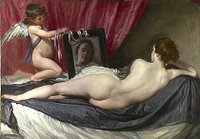
The Rokeby Venus
(The Toilet of Venus)
By Diego Velazquez
1647-51
The National Gallery, London
In the painting the goddess Venus is depicted lying on a bed, looking into a mirror held up by Cupid. The face reflected in the dimmed mirror appears to be that of an older woman, which has long intrigued experts. Some think it is a commentary on the vanity of beauty which is transitory due to aging. Some think the face in the mirror was over-painted by another artist at a later time. Another explanation is that the face is not aged, merely out focus, a sharper face would distract our immediate attention from the form of Venus. By seeing the nude first, and the face afterwards, we are "caught" in voyeurism. The face in the mirror is also substantially larger than it should be, and the mirror is angled such that, in reality, it would reflect a different part of the goddess's body.
The painting is unique for being the only surviving female nude by Velázquez, and one of only two such paintings in all of 17th-century Spanish art, which was often censored by the Spanish Inquisition.

Vieja friendo huevos
(An Old Woman Cooking Eggs)
By Diego Velazques
1618
The National Gallery of Scotland
These early paintings were called bodegones from bodegon, a cheap eating house, and depict common everyday low-life street scenes in a sombre manner with the humble characters portrayed with great dignity and gravitas.

Apollo at the Forge of Vulcan
By Diego Velazques
1630
Museo Nacinal del Prado, Madrid
The Forge of Vulcan; no. 1171, in which Apollo narrates to the astonished Vulcan, the blacksmith of the gods portrayed here as a village blacksmith, the news of the infidelity of Venus, while four others listen to the scandal.
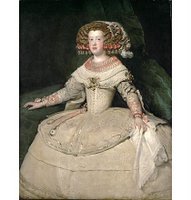
Infanta Maria Teresa
By Diego Velazquez
1652-1653
Kunsthistorisches Museum, Vienna

Mars
By Diego Velazquez
1636-1638
Museo Nacional del Prado
*******
I have been lucky enough to visit both the Apollo at the Forge of Vulcan and Mars at the Museo Nacional del Prado in Madrid. Unfortunately these photos scanned from prints do not do these paintings justice. Standing in front of both of them are absolutely breathtaking!
For the readers who live in London or are planning a visit to the UK, The National Gallery in London has a Current Exhibition from Oct. 18, 2006 to Jan. 21, 2007 featuring Diego Velazquez works. If by chance you visit the gallery, shoot me an email and let me know your thoughts.
Have a wonderful day everyone! Comments are always appreciated.
Labels: The Arts
N Posted by Rain at 11/16/2006 07:09:00 AM

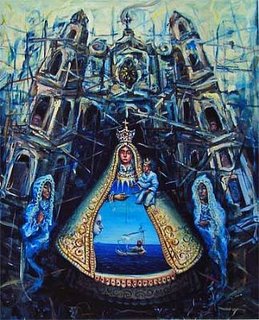
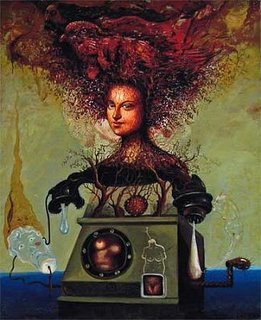 No me llames de madrugada
No me llames de madrugada
(You do not call to me at day break)
By
Williams Carmona

By
Williams Carmona
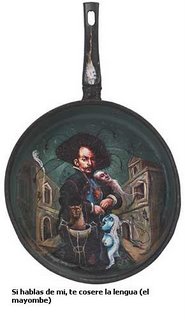
By
Williams Carmona
By
Williams Carmona
Born in Pinar del Rio, Cuba in 1967, Williams Carmona studied at the University of Fine Arts in Havana. Like many of his fellow artists, Carmona left Cuba to explore the artistic freedom available outside his homeland. Since 1991, he has lived and painted in Puerto Rico. While his early works were large and expressionistic, his more mature works have evolved into a new style; one Carmona has labeled Tropical realism. In 1996 the artist was honored with a one-man exhibition in his adopted homeland at the Museo de las Americas in San Juan, Puerto Rico. That same year, Carmona was also invited to participate in the Latin American masters group exhibition, Latin ViewPoints, at the Nassau County Museum of Art, Long Island, New York.
If you happen to be in Los Angeles please stop by the Museum of Latin American Art, visit the Permanent Collection and see Carmona's work for yourself. His work is truly amazing!
Have a great day everyone!
Labels: The Arts
N Posted by Rain at 11/07/2006 09:12:00 AM
